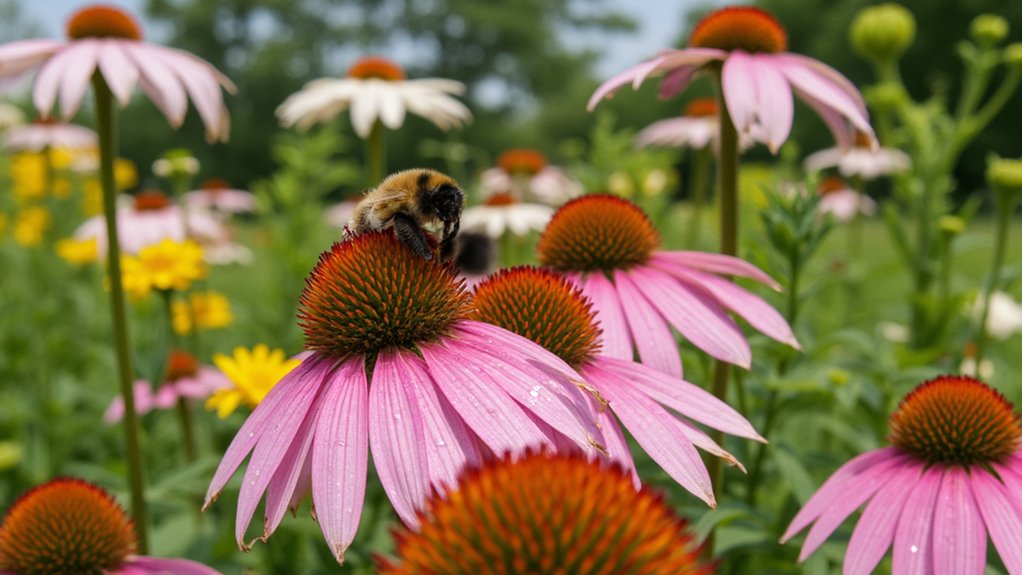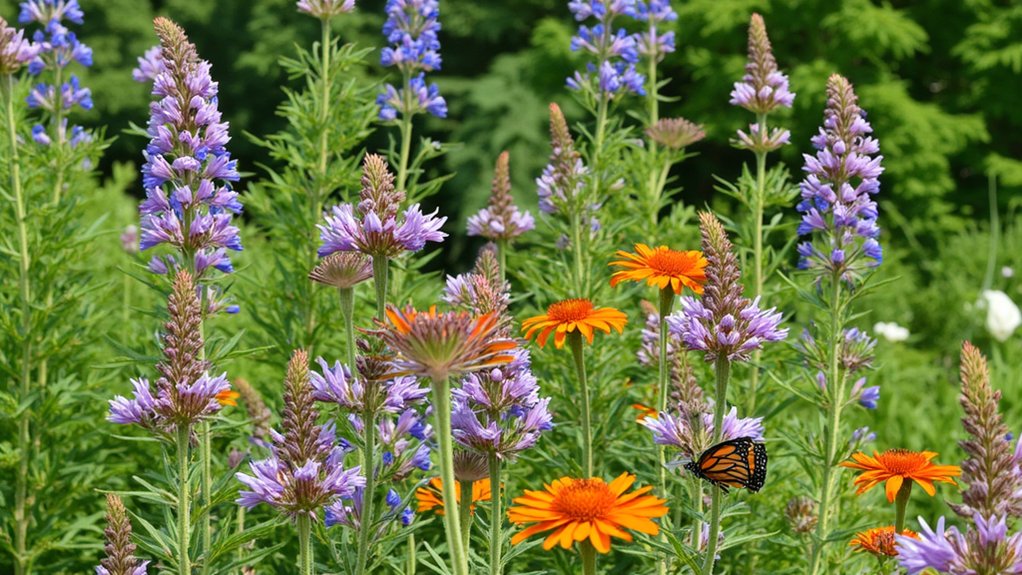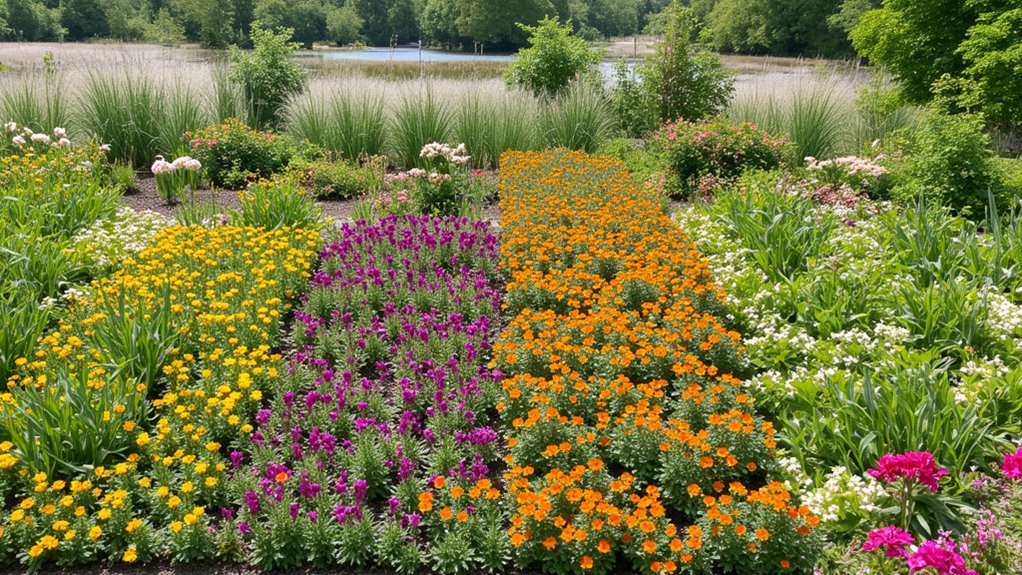As your backyard buzzes with potential, you’ll find that creating a pollinator paradise isn’t just gardening—it’s orchestrating nature’s essential workforce. You can transform your outdoor space into a thriving habitat for bees and butterflies by selecting the right native plants, establishing proper layouts, and maintaining chemical-free zones. Before you grab your gardening tools, though, you’ll need to understand which local species you’re hoping to attract and what makes them tick.
Contents
- 1 Understanding the Role of Pollinators in Your Garden
- 2 Essential Native Plants That Attract Local Pollinators
- 3 Creating a Year-Round Blooming Schedule
- 4 Designing Your Garden Layout for Maximum Impact
- 5 Natural Pest Control Methods That Protect Beneficial Insects
- 6 Water Sources and Shelter Features for Pollinators
- 7 Best Soil Practices for Pollinator-Friendly Plants
- 8 Bee-Specific Plants and Habitat Requirements
- 9 Butterfly Gardens: Species-Specific Considerations
- 10 Maintaining Your Pollinator Paradise Through the Seasons
Understanding the Role of Pollinators in Your Garden

When you’re creating a thriving garden, understanding pollinators isn’t just helpful – it’s essential. These industrious creatures, including bees, butterflies, and hummingbirds, transfer pollen between flowers, enabling plant reproduction and fruit development.
Your garden’s success depends on these tiny workers, who visit 50-1000 flowers per trip. Bees are especially efficient, carrying pollen in specialized leg pouches, while butterflies transport it on their bodies as they search for nectar.
Different pollinators work at various times throughout the day. Bees are most active from 9 am to 3 pm, while moths take the night shift, ensuring continuous pollination in your garden.
Essential Native Plants That Attract Local Pollinators

Native plants serve as powerful magnets for your local pollinators, naturally drawing them into your garden’s ecosystem. For your Northeast garden, plant black-eyed susans, purple coneflowers, and native asters, spacing them 12-18 inches apart in well-drained soil.
In the Southwest, you’ll want to include desert marigolds and penstemons, which thrive in full sun and require minimal water. Plant these drought-resistant species 24 inches apart to accommodate their spreading habits.
For Midwest gardens, incorporate butterfly milkweed, blazing star, and bee balm. These hardy perennials should be planted in spring, with mature plants spaced 18 inches apart for ideal growth and pollinator access.
Creating a Year-Round Blooming Schedule

To maintain a vibrant pollinator garden throughout the growing season, you’ll need to carefully plan your bloom cycles. Start with early spring bloomers like crocus and hellebores, which emerge when temperatures reach 50°F, then shift to mid-spring flowers such as columbine and bleeding hearts.
For summer, incorporate black-eyed susans, bee balm, and native phlox, spacing their planting dates 2-3 weeks apart. Don’t forget late-season performers like asters, goldenrod, and sedum for autumn nectar sources.
Map your garden’s bloom schedule on a calendar, noting each plant’s flowering period. This guarantees you’ll have continuous nectar sources from March through October.
Designing Your Garden Layout for Maximum Impact
Since successful pollinator gardens depend on strategic placement, you’ll need to arrange your plants in distinct clusters rather than scattered individual specimens. Create groupings of at least 3-4 identical plants, spaced 12-18 inches apart, to form visually appealing blocks that attract pollinators from a distance.
Position taller plants like Joe Pye weed and butterfly bush toward the back, medium-height plants like coneflowers in the middle, and shorter options like creeping thyme in front. Leave 2-3 foot wide paths between plant clusters to allow for maintenance access.
Consider wind protection when laying out your garden, as pollinators prefer sheltered areas for feeding.
Natural Pest Control Methods That Protect Beneficial Insects
While maintaining a thriving pollinator garden requires pest management, harsh chemical pesticides can harm the very insects you’re trying to attract. Instead, incorporate companion planting with pest-deterrent species like marigolds, lavender, and chrysanthemums throughout your garden beds.
Create physical barriers using row covers during peak pest seasons, but remember to remove them when plants are flowering. You can also introduce beneficial predators like ladybugs and praying mantises, which naturally control aphids and other destructive insects.
For persistent problems, use organic solutions like neem oil or insecticidal soaps, applying them at dusk when pollinators are less active. Always spot-treat affected areas rather than spraying broadly.
Water Sources and Shelter Features for Pollinators
Beyond protecting pollinators from pests, your garden should provide them with basic necessities for survival. Water sources are essential, but they don’t need to be elaborate – a shallow dish with pebbles or floating cork pieces works perfectly, allowing insects to drink without drowning.
Create shelter zones by installing bee houses 3-5 feet above ground, facing southeast. You’ll also want to leave some bare soil patches and maintain brush piles for ground-nesting bees. For butterflies, position flat rocks in sunny spots where they can bask, and include some muddy areas they’ll use to extract minerals.
Remember to clean water sources weekly and replace deteriorating shelters annually.
Best Soil Practices for Pollinator-Friendly Plants
To nurture thriving pollinator-friendly plants, you’ll need soil that’s both well-draining and nutrient-rich. Start by testing your soil’s pH level, aiming for a range between 6.0 and 7.0, which most flowering plants prefer.
Mix in organic compost until it makes up 30% of your soil composition, and add a 2-inch layer of mulch to retain moisture. You’ll want to maintain soil structure by avoiding excessive tilling, as many pollinators nest in the ground.
For clay-heavy soils, incorporate peat moss and sand at a 1:1:1 ratio with existing soil. Remember to refresh your organic matter annually, preferably in early spring before active growth begins.
Bee-Specific Plants and Habitat Requirements
Since bees require specific plants for both nectar and pollen, you’ll want to include varieties that bloom throughout the growing season. Native plants like echinacea, black-eyed susans, and bee balm are excellent choices, producing abundant nectar from spring through fall.
Create clusters of the same plant species, spacing them 12-18 inches apart. Bees prefer landing on flat or tubular flowers, so incorporate plants like salvias, lavender, and catmint into your garden design.
Don’t forget to provide a water source and bare soil patches for ground-nesting bees. Install a shallow dish with pebbles and water, keeping the depth at 1/2 inch or less to prevent drowning.
Butterfly Gardens: Species-Specific Considerations
Creating a butterfly sanctuary requires careful attention to both nectar sources and host plants for caterpillars. You’ll need to include at least three types of milkweed for monarchs, while swallowtails prefer parsley, dill, and fennel. Space these host plants 18-24 inches apart in sunny locations.
For nectar, plant clusters of butterfly bush, zinnias, and lantana in groups of five or more. These flowering plants should bloom at different times throughout the season. Don’t forget to include flat rocks for basking and shallow puddles for puddling, where butterflies gather minerals from damp soil.
Maintaining Your Pollinator Paradise Through the Seasons
While most gardens rest during winter, your pollinator paradise needs year-round attention to thrive. Clear away dead foliage in late fall, but leave some hollow stems standing as winter shelter for beneficial insects.
In spring, divide overcrowded perennials and add fresh compost to rejuvenate soil nutrients. Summer requires consistent deadheading to encourage continuous blooming, plus weekly deep watering during dry spells.
Keep fall interesting by letting seed heads mature—they’ll feed birds and self-sow for next year. Throughout the seasons, maintain a 3-inch layer of mulch, but keep it away from plant stems to prevent rot and fungal issues.
